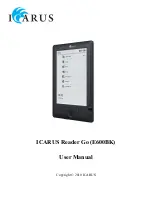
Appendix G – Bar Code Details
228
Class Series 2 Programmer’s Manual
Error Correction
Size 001 to 099:
This value specifies the percent of symbol code words to be used for
error correction. Actual error correction word percentage will vary depending on data.
The default value, approximately 23%, is recommended. Any other value may be
selected to meet the user’s needs. Some minimum-security code word may be
generated depending on the data sent for encoding, particularly when the volume of that
data is small. It the data capacity is exceeded no symbol is printed.
Size 101 to 104: Values 101 through 104 results in 1 through 4 layers (two modules
thick) respectively, around the center finder pattern. Data volume constraints apply as
indicated in the table above. Symbols will be of the compact form. All available code
word will be used for error correction. It the data capacity is exceeded no symbol is
printed.
Size 201 to 232: Values 201 through 232 result in 1 through 32 layers (two modules
thick) respectively, around the center finder pattern. Data volume constraints apply as
indicated in the table above. Symbols will be of the full-size form. All available
codewords will be used for error correction. It the data capacity is exceeded no symbol
is printed.
Size 300: Value 300 informs the printer that the data, which follows will be used to
encode one RUNE symbol. The data consists of one to three ASCII digits with value
range of 0 to 256. The data may include leading zeros. Data streams longer than three
digits or data that includes non-numeric characters may have unpredictable results.
Extended Channel Interpretation Mode:
A value of 1 provides for extended channel
codewords to be inserted into the bar code symbol, using escape sequences in the
datastream. This mode also provides for effective Code 128 and UCC/EAN 128
emulations, when used in with appropriately configured bar code readers. The valid
values for escape sequences are of the form <ESC>n, where:
<ESC> –
1 byte with value
27
10
= 1B
16
n –
1 ASCII digit, range 0 through 6
These escape sequences are encoded as FLG(n) character pairs described in the
International Symbology Specification – Aztec Code, AIM, 1997-11-05, and the
meanings of the values for n are the same in both.
<ESC>0 –
Is encoded as FLG(0), and interpreted as FNC1 or <
G
S
> depending on its
location in the data stream. The printer does not validate <ESC>0
locations in the data stream.
When <ESC>0 is the leading data in the stream, it is interpreted as a
FNC1 as used in the Code 128 symbology, and specifically for UCC/EAN
128 applications. For appropriately configured scanners this will be
interpreted/transmitted as a ]C1 symbology identifier preamble. The
printer does not validate UCC/EAN 128 data syntax.
When <ESC>0 follows a single alphabetic or two numeric characters
respectively, then it also interpreted as a FNC1. For appropriately
configured scanners this would be interpreted/transmitted as a ]C2
symbology identifier preamble, and the alpha or numeric characters
Summary of Contents for MP Compact4 Mark II
Page 2: ......
Page 4: ......
Page 20: ...Overview 8 Class Series 2 Programmer s Manual...
Page 28: ...Immediate Command Functions 16 Class Series 2 Programmer s Manual...
Page 136: ...Extended System Level Command Functions 124 Class Series 2 Programmer s Manual...
Page 156: ...Label Formatting Command Functions 144 Class Series 2 Programmer s Manual...
Page 176: ...Generating Label Formats 164 Class Series 2 Programmer s Manual...
Page 188: ...Appendix B Sample Programs 176 Class Series 2 Programmer s Manual...
Page 196: ...Appendix D Reset Codes 184 Class Series 2 Programmer s Manual...
Page 208: ...Appendix E Single Byte Symbol Sets 196 Class Series 2 Programmer s Manual...
Page 260: ...Appendix G Bar Code Details 248 Class Series 2 Programmer s Manual...
Page 304: ...Appendix Q Plug and Play IDs 292 Class Series 2 Programmer s Manual...
Page 308: ...Appendix R Line Mode 296 Class Series 2 Programmer s Manual...
Page 320: ...Appendix T WiFi Region Country Codes 308 Class Series 2 Programmer s Manual...
Page 330: ......















































